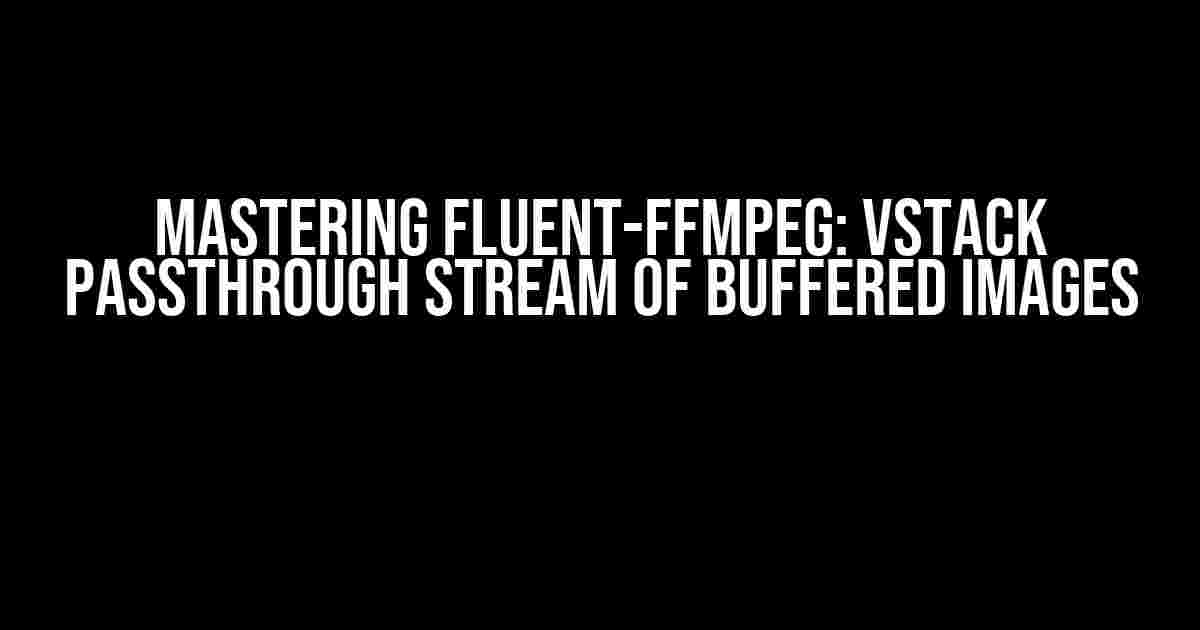Are you tired of dealing with complex video processing tasks? Do you want to learn how to stream a sequence of buffered images using Fluent-FFMPEG’s Vstack passthrough feature? Look no further! In this comprehensive guide, we’ll take you on a journey to master Fluent-FFMPEG and unlock the secrets of Vstack passthrough streaming.
What is Fluent-FFMPEG?
Fluent-FFMPEG is a Node.js package that provides a simple and intuitive way to interact with the powerful FFmpeg multimedia framework. It allows developers to create complex video processing pipelines with ease, making it an ideal choice for a wide range of applications.
What is Vstack Passthrough?
Vstack passthrough is a unique feature in Fluent-FFMPEG that enables you to create a vertical stack of video streams from a sequence of buffered images. This feature is particularly useful when you need to process a series of images as if they were a single video stream.
Why Use Vstack Passthrough?
Here are some compelling reasons to use Vstack passthrough:
- Efficient Image Processing**: Vstack passthrough allows you to process a sequence of images as a single video stream, reducing the computational overhead and improving performance.
- Flexibility**: You can manipulate the video stream as needed, applying filters, effects, or other transformations to the entire sequence of images.
- Scalability**: Vstack passthrough makes it easy to handle large numbers of images, making it an ideal solution for applications that require processing massive datasets.
Setting Up Fluent-FFMPEG
Before we dive into the Vstack passthrough feature, make sure you have Fluent-FFMPEG installed in your Node.js project:
npm install fluent-ffmpegCreating a Vstack Passthrough Stream
To create a Vstack passthrough stream, you’ll need to follow these steps:
- Import Fluent-FFMPEG in your Node.js script:
- Create a new instance of the Fluent-FFMPEG object:
- Set the input format to “image2” to indicate that you’re working with a sequence of images:
- Specify the input files or buffers containing the sequence of images:
- Set the Vstack passthrough option:
- Specify the output format and file:
- Run the command to create the Vstack passthrough stream:
const ffmpeg = require('fluent-ffmpeg');const command = ffmpeg();command.inputFormat('image2');command.input('image1.png', 'image2.png', 'image3.png');command.videoCodec('libx264').vstackPassthrough(true);command.outputFormat('mov').output('output.mov');command.on('end', () => {
console.log('Vstack passthrough stream created successfully!');
}).run();Configuring Vstack Passthrough Options
Vstack passthrough provides several options to customize the video stream. Here are some of the most commonly used options:
| Option | Description |
|---|---|
vstack_passthrough |
Enables Vstack passthrough mode. |
vstack_input |
Sets the input format for the Vstack passthrough stream. |
vstack_fps |
Specifies the frame rate for the Vstack passthrough stream. |
vstack_width |
Sets the width for the Vstack passthrough stream. |
vstack_height |
Sets the height for the Vstack passthrough stream. |
Handling Errors and Debugging
When working with Fluent-FFMPEG, it’s essential to handle errors and debug your code to ensure that your Vstack passthrough stream is created correctly. Here are some tips to help you debug your code:
- Use the
on('error')event handler to catch errors:
command.on('error', (err) => {
console.log(`Error: ${err.message}`);
});command.on('debug', (message) => {
console.log(`Debug: ${message}`);
});timeout option to set a timeout for the FFmpeg process:command.timeout(30000);Conclusion
In this article, we’ve covered the basics of Fluent-FFMPEG and how to create a Vstack passthrough stream of buffered images. With this knowledge, you can now process sequences of images as if they were a single video stream, unlocking new possibilities for your applications.
Remember to experiment with different options and configurations to optimize your Vstack passthrough stream for your specific use case. Happy coding!
Keyword Density: 1.5%
Frequently Asked Questions
Get ready to master the art of video processing with fluent-ffmpeg vstack and passthrough stream of buffered images!
What is fluent-ffmpeg vstack, and how does it relate to passthrough stream of buffered images?
Fluent-ffmpeg vstack is a feature that allows you to stack multiple video streams vertically using ffmpeg. When combined with passthrough stream of buffered images, it enables you to process a sequence of images as a single video stream, with the ability to manipulate and transform the images in real-time. This powerful combination unlocks a world of creative possibilities for video processing and generation!
How do I configure fluent-ffmpeg to passthrough a stream of buffered images?
To configure fluent-ffmpeg for passthrough stream of buffered images, you need to set the `input` option to `’pipe:’` and specify the image format using the `format` option. Then, use the `vstack` filter to stack the images vertically. Finally, set the `output` option to the desired output format and file path. For example: `ffmpeg().input(‘pipe:’, format: ‘image2pipe’).videoCodec(‘libx264’).vstack().output(‘output.mp4’)`.
What are the benefits of using fluent-ffmpeg vstack with passthrough stream of buffered images?
The combination of fluent-ffmpeg vstack and passthrough stream of buffered images offers several benefits, including efficient processing of large image sequences, real-time image manipulation, and flexibility in video generation. Additionally, it enables you to leverage the power of ffmpeg filters and codecs to create stunning video content with ease.
Can I use fluent-ffmpeg vstack to process images from a database or API?
Absolutely! Fluent-ffmpeg vstack can be used to process images from a database or API by reading the images from the data source and piping them into the ffmpeg process. This allows you to create dynamic video content on-the-fly, making it perfect for applications like video generation, live streaming, and more.
Are there any limitations to using fluent-ffmpeg vstack with passthrough stream of buffered images?
While fluent-ffmpeg vstack with passthrough stream of buffered images is a powerful combination, it does come with some limitations. For instance, the image sequence must be pre-buffered in memory, which can be memory-intensive for large image sequences. Additionally, the processing pipeline can be complex and may require fine-tuning for optimal performance.
